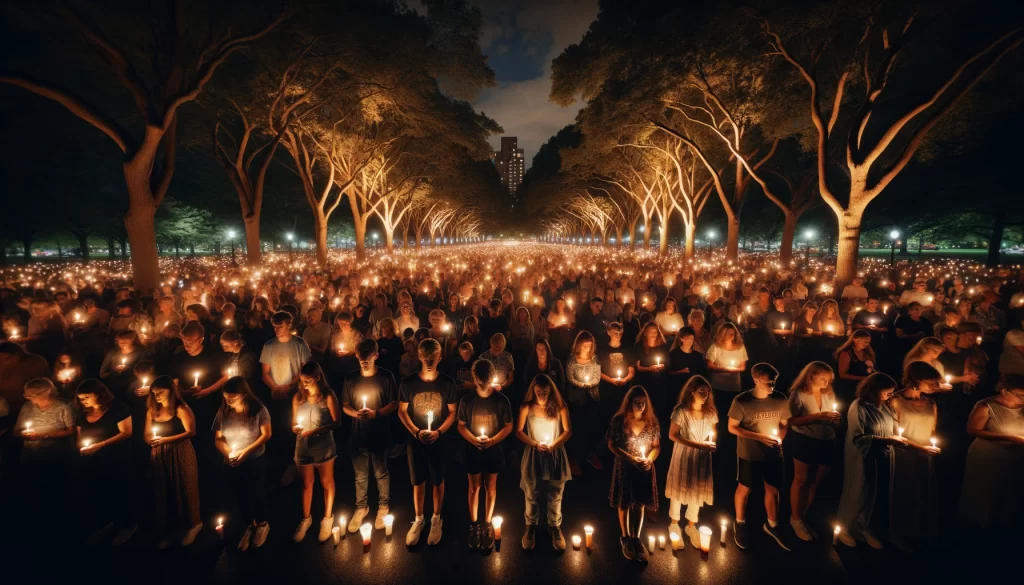Over 133 people lost their lives and more than 100 got hurt in a shocking and tragic incident at a concert in Moscow’s Crocus City Hall. This happened on Friday, just before a band from the Soviet era was about to perform.
A group of attackers, dressed in camouflage uniforms, suddenly started shooting and even threw explosives at the crowd inside the venue. The place ended up catching fire, and parts of the building, including the roof, were destroyed.
The next day, news came out that eleven suspects were caught by the authorities, with four of them believed to have directly taken part in the attack, as reported by Russia’s Interfax news agency.
The attack was claimed by the Afghan branch of the Islamic State of Iraq and the Levant (ISIL), also known as the Islamic State – Khorasan Province (ISKP or ISIS-K). The United States confirmed that this claim was true, according to reports from Reuters news agency.
Now, let’s talk a bit about ISIL’s Afghan branch and why they might have done this.
What Is ISIL’s Afghan Branch?
This group is a key part of ISIL and is named after a historic empire that covered parts of what are now Afghanistan, Iran, Pakistan, and Turkmenistan.
It popped up in eastern Afghanistan around the end of 2014, formed by members who left the Pakistan Taliban and others who supported ISIL’s leader at the time, Abu Bakr al-Baghdadi. They’ve become known for their extremely violent actions.
A military expert named Murat Aslan shared that this group doesn’t hold back and chooses targets based on their radical beliefs. “First of all, Russia is in Syria and fighting against Daesh [ISIL] like the United States. That means they see such countries as hostile,” he explained during an interview with Al Jazeera.
He also noted that the group has carried out attacks in other countries and might continue to do so.
Despite a decrease in their numbers in Afghanistan since around 2018, they still challenge the Taliban’s control there.
Past Attacks
The group has been behind several horrifying incidents, including an attack at Kabul airport in 2021, killing at least 175 civilians, 13 US soldiers, and injuring many.
They also attacked a maternity ward in Kabul in 2020, resulting in the deaths of 24 people, including newborns and women. Later that year, they struck Kabul University, killing at least 22.
In 2022, they claimed a suicide bombing at the Russian embassy in Kabul. They’ve been blamed for attacks in Iran as well, including assaults on a major shrine in Shiraz that killed 14 and injured over 40, and a coordinated bombing in Kerman that killed nearly 100.
Why Target Russia?
Experts think ISIL has been focusing a lot on criticizing Russian President Vladimir Putin, especially about how Muslims are treated in Russia.
Michael Kugelman, an expert at the Wilson Center, explained that Russia’s past actions, like their military moves in Afghanistan, Chechnya, Syria, and parts of Africa, really upset ISIL. Because of this, Russia is a big topic in ISIL’s messages to its followers.
Amira Jadoon, a professor at Clemson University, pointed out that Russia fights against ISIL and works with the Afghan Taliban, ISIL’s enemy. This makes Russia a major target for ISIL, which in turn means that they can strike within Russia itself.
Jadoon mentioned that by attacking countries like Iran and Russia, ISIL wants to prove it’s still powerful and relevant on the world stage.

Kabir Taneja, from the Observer Research Foundation, said ISIL sees Russia as an enemy of Muslims. This isn’t something new, but the way ISIL acts on it has evolved. For example, ISIL has tried to harm Russian interests, including an attack on the Russian embassy in Kabul in 2022.
Early in March, Russia said it stopped an ISIL plan to attack a synagogue in Moscow. The fact that Russia is friends with the Taliban and has close ties with Israel makes things even more complicated, according to experts.
ISIL has also gotten stronger after facing setbacks in Syria and Iran, Taneja added. The group is more about spreading its ideology now, even if it’s not as powerful in other ways.
ISIL’s Reactions to the Moscow Attack
After the attack in Moscow, ISIL’s social media was full of celebration, according to Abdul Basit from the S Rajaratnam School of International Studies. They used this moment to boost their image, which helps them get more support and resources.
Basit warned that more attacks could happen, especially because ISIL members from Central Asia, who fought in Syria, are back in their home regions and capable of carrying out attacks.
The Group’s History in Russia
Russia has faced attacks before. In 2002, over 900 people were taken hostage in a Moscow theater by Chechen fighters. The situation ended tragically when Russian forces used gas to try and take control, leading to many deaths.
The most devastating attack was the 2004 school siege in Beslan by a Chechen group, which resulted in the deaths of 334 people, including 186 children.
This article is based on the following article:
https://www.aljazeera.com/news/2024/3/23/moscow-concert-hall-attack-why-is-isil-targeting

Background Information
Understanding these dynamics provides a foundational context to the reported attack in Moscow and the ongoing global struggle against ISIL and its affiliated groups. This complex interplay of regional conflicts, international politics, and ideological battles shapes the security landscape globally, affecting nations and their citizens.
1. Islamic State of Iraq and the Levant (ISIL) Overview
- Origin and Ideology: ISIL, also known as ISIS (Islamic State of Iraq and Syria), emerged from the chaos of the Iraq War in the early 2000s. Its roots trace back to extremist groups that pledged allegiance to al-Qaeda. However, ISIL’s brutal tactics and its aim to establish a so-called Islamic caliphate under strict Sharia law led it to break away and gain notoriety.
- Territorial Control and Decline: At its height in 2014-2015, ISIL controlled large swathes of territory in Iraq and Syria. However, international and local forces have significantly diminished its control on the ground. Despite losing territorial claims, ISIL continues to operate as a guerrilla force and inspires global terror networks.
2. Russian Involvement in Global Conflicts
- Chechnya: Russia has faced insurgencies within its borders, most notably in Chechnya. The Chechen wars (First Chechen War 1994-1996 and Second Chechen War 1999-2009) were attempts by Chechen forces to gain independence from Russia, leading to significant violence and atrocities.
- Syria: Russia has been a key player in the Syrian Civil War, supporting the government of Bashar al-Assad against various opposition groups, including ISIL. Russian military intervention, starting in 2015, has significantly impacted the war’s course.
- Afghanistan: Historically, the Soviet Union (Russia’s predecessor) invaded Afghanistan in 1979, leading to a decade-long conflict. More recently, Russia has been involved in diplomatic efforts and has had interactions with various Afghan factions, including the Taliban, in the post-2001 era.
3. Islamic State – Khorasan Province (ISKP/ISIS-K)
- Formation and Goals: ISKP is the branch of ISIL active in South Asia and Central Asia, particularly Afghanistan and Pakistan. It was established around 2014-2015 by former Taliban members who pledged allegiance to ISIL. ISKP aims to expand the Islamic State’s ideology into the Khorasan region, a historical area covering parts of today’s Iran, Central Asia, Afghanistan, and Pakistan.
- Threats and Attacks: ISKP has conducted numerous terror attacks, targeting both civilian and military entities. Its brutality is aimed at destabilizing the region and showcasing its reach and power, despite international efforts to counter its activities.
4. The Global Fight Against ISIL
- International Coalition: An international coalition led by the United States has conducted military operations against ISIL in Iraq and Syria, aiming to destroy its operational capabilities and recapture territories. Similar efforts are ongoing in other regions where ISIL has a presence.
- Complex Alliances: The fight against ISIL involves a complex web of alliances and rivalries. For instance, the Afghan Taliban, while ideologically similar in some respects, opposes ISKP due to territorial and power disputes.
5. Impact on Civilians
- Humanitarian Crisis: ISIL’s actions and the conflicts in Chechnya, Syria, and Afghanistan have led to massive humanitarian crises, with millions of people displaced, injured, or killed.
- Global Security Concerns: The spread of ISIL’s ideology and its call for lone-wolf attacks have raised security concerns worldwide, leading to increased efforts in counter-terrorism and security measures.

Debate/Essay Questions
- Is the military intervention by global powers in conflict zones like Syria and Afghanistan effective in combating terrorism, or does it exacerbate the problem?
- How should the international community respond to countries that provide indirect support to terrorist groups due to geopolitical interests?
- What role should the United Nations play in coordinating the global fight against organizations like ISIL?
Please subscribe to Insight Fortnight, our biweekly newsletter!
